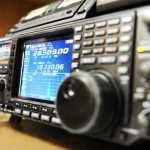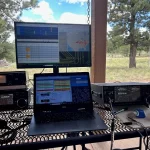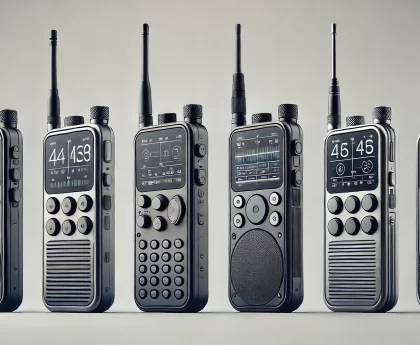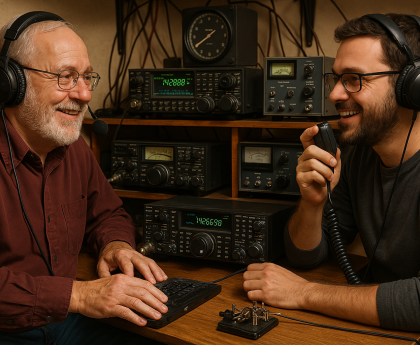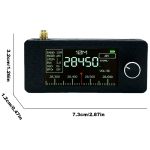Join our Exclusive Ham Radio Newsletter
For radio enthusiasts and amateur operators, DXing (long-distance radio communication) in the HF (High Frequency) bands is a fascinating hobby. One common question that arises among newcomers is: Why is AM (Amplitude Modulation) preferred over FM (Frequency Modulation) for DXing in HF? While both modulation types have their advantages, AM has distinct characteristics that make it superior for long-distance communication in HF bands.
1. AM vs. FM: The Basics
- AM (Amplitude Modulation) varies the amplitude of the carrier wave to encode information while keeping frequency constant.
- FM (Frequency Modulation) varies the frequency of the carrier wave while maintaining a constant amplitude.
Both methods are widely used, but FM is more common in VHF/UHF bands, while AM remains dominant in HF.
2. Why is AM Better Than FM for HF DXing?
2.1. Bandwidth Efficiency and Spectrum Usage
One of the biggest reasons AM is better suited for DXing in HF is bandwidth efficiency.
- AM typically requires 6-9 kHz of bandwidth, while FM requires 10-15 kHz or more.
- The HF bands are limited in available spectrum, and FM’s higher bandwidth requirements make it impractical for DXing, where multiple stations operate in crowded conditions.
2.2. Propagation and Ionization Effects
HF signals rely on ionospheric reflection for long-distance propagation.
- AM signals propagate more efficiently due to their narrow bandwidth and ability to be reflected and refracted by the ionosphere.
- FM signals struggle with ionospheric propagation, as the varying frequency components are distorted by Doppler effects and multipath reflections.
2.3. Signal-to-Noise Ratio and Weak Signal Performance
- AM receivers can extract intelligible audio from weak signals, even when the signal-to-noise ratio (SNR) is low.
- FM signals, however, require a stronger signal to maintain clarity. If the FM signal drops below a certain threshold, it becomes completely unreadable due to the capture effect (where only the strongest signal is heard, while weaker ones are suppressed).
- In contrast, AM allows for partial intelligibility even at lower signal strengths.
2.4. Equipment Compatibility and Simplicity
- AM receivers are simpler and widely available across different HF bands. Many shortwave and ham radio receivers are optimized for AM.
- FM requires wider IF filters and special demodulators, which are uncommon in HF radios.
- Most HF radios do not support FM natively, but almost all include AM as a standard mode.
2.5. Lower Power Requirements for DXing
- AM signals can be received over long distances with lower power compared to FM.
- FM requires stronger transmission power to be effective over long distances, making it less practical for DXing, where power efficiency is key.
3. Why is FM Used in Higher Bands (VHF/UHF)?
FM dominates VHF (Very High Frequency) and UHF (Ultra High Frequency) bands for local communication because:
- VHF/UHF signals travel mostly line-of-sight, where FM’s clarity and noise resistance make it ideal.
- FM’s capture effect eliminates interference from weaker stations.
- Wideband FM supports high-fidelity audio, making it superior for commercial broadcasting (e.g., FM radio).
However, these benefits do not translate well to HF bands, where AM excels due to propagation characteristics.
Conclusion
For DXing in HF bands, AM is far superior to FM due to its narrower bandwidth, better weak-signal performance, ionospheric propagation compatibility, and simpler receiver requirements. While FM remains excellent for local communications in VHF/UHF, its drawbacks make it impractical for long-distance HF communication.
For serious HF DXers, AM remains the preferred modulation mode for reliable long-distance reception and transmission.
Check our selection of Hamradio e-books
-
Sale!

Mastering APRS
Original price was: $59.99.$27.00Current price is: $27.00.
A Comprehensive Guide – ebook
⭐⭐⭐⭐⭐ -
Sale!

Mastering FT8
Original price was: $59.99.$27.00Current price is: $27.00.
A Comprehensive Guide to the Ultimate Digital Mode – ebook
⭐⭐⭐⭐⭐ -
Sale!

Stealth CB Antennas
Original price was: $59.99.$27.00Current price is: $27.00.
A Masterclass in Innovation and Disguise – ebook
⭐⭐⭐⭐⭐ -
Sale!

Ace Your Ham Radio Exam
Original price was: $59.99.$27.00Current price is: $27.00.
Technician, General, and Extra Class – ebook
⭐⭐⭐⭐⭐ -
Sale!

DMR for Hams
Original price was: $59.99.$27.00Current price is: $27.00.
The Ultimate Beginner’s Guide – ebook
⭐⭐⭐⭐⭐ -
Sale!

D-STAR, DMR & Fusion
Original price was: $59.99.$27.00Current price is: $27.00.
A Beginner’s Guide – ebook
⭐⭐⭐⭐⭐ -

Mastering the 6-Meter Band
$27.00
The Ultimate Guide – ebook
⭐⭐⭐⭐⭐ -
Sale!

Integrating Ham Radio with Modern Technology
Original price was: $59.99.$27.00Current price is: $27.00.
IoT, Raspberry Pi, and More – ebook
⭐⭐⭐⭐⭐ -
Sale!

D-STAR, DMR & Fusion
Original price was: $59.99.$27.00Current price is: $27.00.
Guia para Principantes – ebook
⭐⭐⭐⭐⭐ -
Sale!
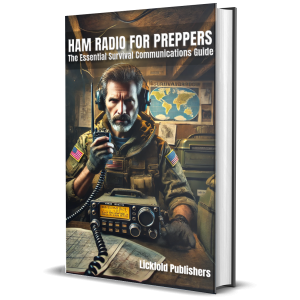
Ham Radio for Preppers
Original price was: $59.99.$27.00Current price is: $27.00.
The Essential Survival Communications Guide – ebook
⭐⭐⭐⭐⭐ -
Sale!

Mastering Marine Radio
Original price was: $59.99.$27.00Current price is: $27.00.
A Sailor’s Guide to Confident Communication – ebook
⭐⭐⭐⭐⭐

Enter shop


